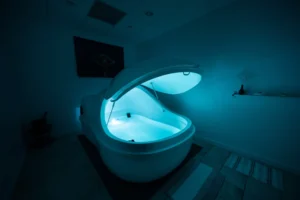Chronic pain affects millions of people worldwide, disrupting daily life and often leading to long-term health issues. Traditional pain management methods frequently rely on medications with potential side effects. This is why more individuals are exploring alternative, natural therapies one of which is Float Session Therapy.
In this blog, we’ll explore the science behind float therapy, the benefits of float therapy for chronic pain relief, and why float session therapy is becoming a preferred natural solution. We’ll also dive into related topics like sensory deprivation float therapy, isolation tank therapy, and the health benefits of float therapy.
What Is Float Session Therapy?
If you’re wondering “Float Therapy what is it?”, the answer is simple but profound. Float session therapy involves floating effortlessly in a specially designed tank filled with highly concentrated Epsom salt water. These sensory deprivation float tanks create an environment free from external stimuli light, sound, and gravity allowing your body and mind to relax deeply.
The purpose of sensory deprivation tank sessions is to provide a unique, calm space where your body can reduce stress, recover from physical pain, and promote healing naturally. This method is also known as isolation tank therapy or simply float therapy session.
The Science Behind Float Therapy
The science behind float therapy shows that this environment encourages the body to enter a deep state of relaxation. By reducing sensory input, your nervous system calms down, helping decrease inflammation and muscular tension that often contribute to chronic pain.
Studies highlight the effects of float therapy on reducing cortisol, a stress hormone linked to pain amplification. Additionally, magnesium sulfate in the saltwater absorbs through the skin, promoting muscle relaxation and pain relief.
Benefits of Float Therapy for Chronic Pain Management
When considering float session therapy for chronic pain, it’s important to understand the broad spectrum of float session benefits it offers:
1. Natural Pain Relief
The buoyancy in the float deprivation tank reduces pressure on joints and muscles, providing relief from conditions like arthritis, fibromyalgia, and back pain. Unlike medications, there are no side effects.
2. Reduced Inflammation
Magnesium-rich water in the tank promotes muscle relaxation and reduces inflammation, which is a major factor in chronic pain.
3. Stress and Anxiety Reduction
Chronic pain and anxiety often go hand-in-hand. The benefits of sensory deprivation float tanks include a significant reduction in anxiety, helping improve overall wellbeing and pain tolerance.
4. Improved Sleep Quality
Pain disrupts sleep, but the health benefits of float therapy include enhanced sleep patterns, essential for natural healing.
Why Float Session Therapy Stands Out
Many people ask, why choose float session therapy over other methods?
The benefits of floatation tanks are holistic. This therapy not only targets physical pain but also addresses mental health issues such as float therapy for depression and float tank anxiety.
The Benefits of Float Therapy in Daily Life
Incorporating float therapy sessions into your routine can lead to long-term improvements in pain management. Some of the key benefits of float therapy include:
- Deep relaxation and rejuvenation
- Reduction in muscle tension and spasms
- Enhanced blood circulation
- Mental clarity and emotional balance
Understanding Sensory Deprivation Float Therapy
Sensory deprivation float therapy reduces external stimuli, allowing the brain to switch from beta waves (active thinking) to theta waves, which promote healing and regeneration.
The purpose of sensory deprivation tank sessions is to create an environment that supports mental and physical recovery ideal for chronic pain sufferers.
How Does a Float Therapy Session Work?
A typical float therapy session lasts about 60-90 minutes. You enter the isolation tank therapy room, remove distractions, and float in warm saltwater. The absence of sensory inputs lets your body switch into a deep healing mode, helping relieve chronic pain and reduce stress.
Additional Float Tank Therapy Benefits
Besides pain relief, float tank therapy benefits include:
- Reduced muscle fatigue
- Improved immune function
- Enhanced mood and reduced symptoms of depression
- Better sleep patterns
- Heightened creativity and focus
Float Therapy for Relaxation and Mental Health
The benefits of float therapy extend to mental health. Many report relief from anxiety, stress, and depression after regular sessions. This holistic effect is why many consider float therapy for relaxation as essential as physical pain management.
What You Should Know Before Your First Float Session Therapy
If you are new to float therapy session, here are a few things:
- Sessions typically last between 60-90 minutes.
- You float in a dark, soundproof tank filled with Epsom salt water at skin temperature.
- You are encouraged to relax fully to get the most out of the session.
- Many experience immediate pain relief and relaxation.
FAQ About Float Session Therapy and Chronic Pain
1. What is the main purpose of float session therapy?
The purpose of sensory deprivation tank sessions is to promote deep relaxation and natural pain relief by minimizing sensory inputs.
2. How often should I do float therapy for chronic pain?
Consistency is key. Many recommend at least weekly sessions initially, then adjusting based on pain levels and benefits experienced.
3. Can float therapy help with anxiety and depression?
Yes, float therapy for depression and float tank anxiety are well-documented benefits, as the sessions help calm the nervous system.
4. Is float session therapy safe?
Float therapy is generally safe for most people. However, individuals with certain health conditions should consult a doctor first.
5. What are the effects of float therapy on sleep?
Many report improved sleep quality after sessions due to deep relaxation and reduced pain.
6. How does float therapy compare to medication for pain?
Unlike medication, float session therapy offers a natural, side-effect-free method of managing pain and promoting healing.
7. What are the benefits of sensory deprivation float tanks?
These tanks help reduce stress, relieve muscle tension, and promote mental clarity and relaxation.
Conclusion
In conclusion, float session therapy is a powerful natural alternative for managing chronic pain. The benefits of float therapy from reduced inflammation to improved mental health make it a compelling option for those seeking relief without drugs or invasive treatments.
By embracing the science behind float therapy and understanding the wide-ranging health benefits of float therapy, you can take control of your pain and improve your quality of life through this innovative and relaxing therapy.





